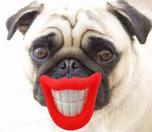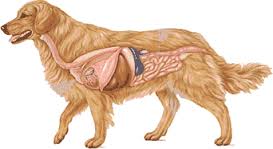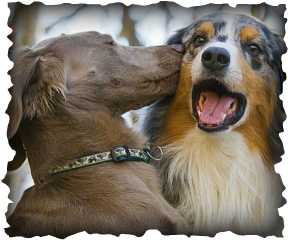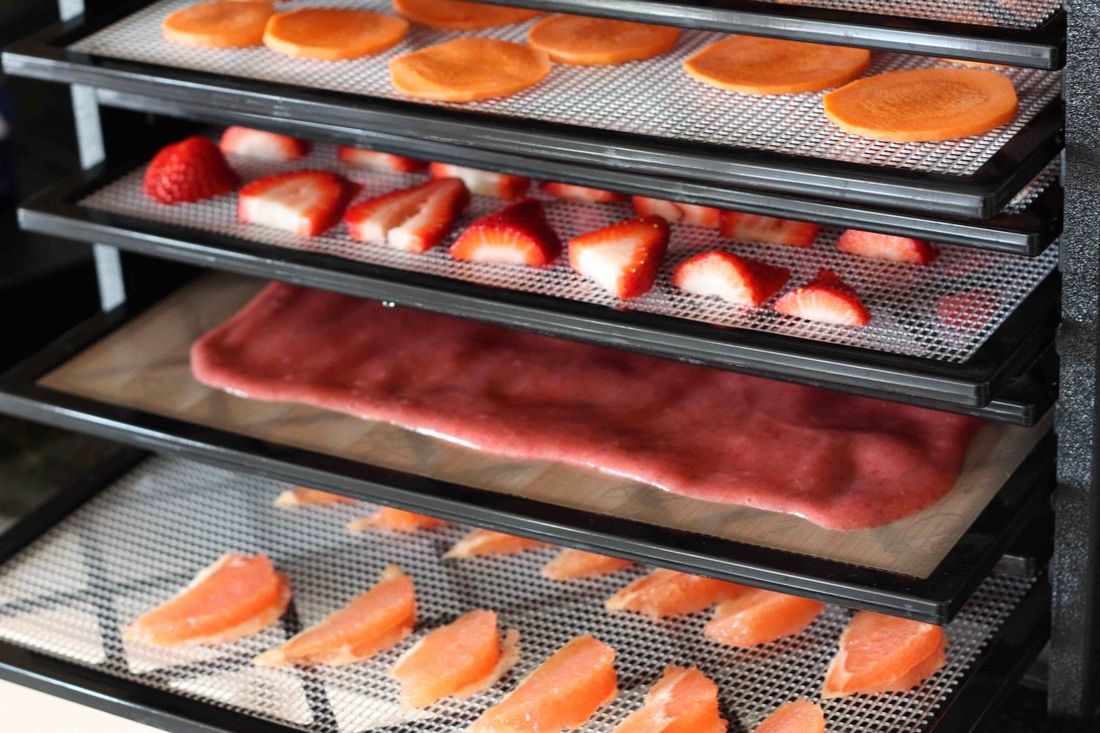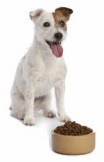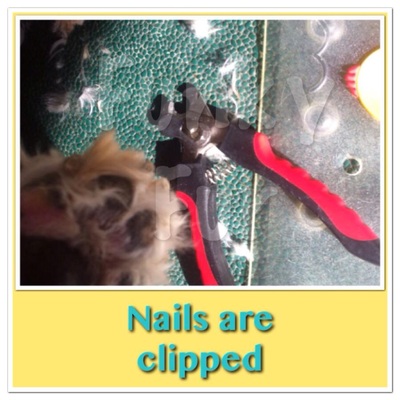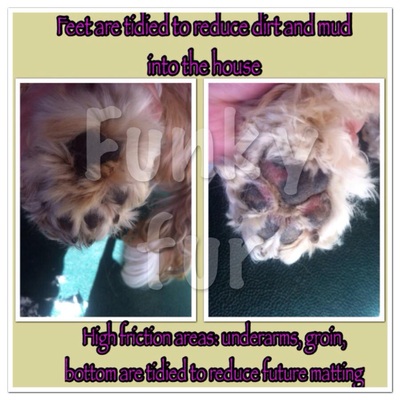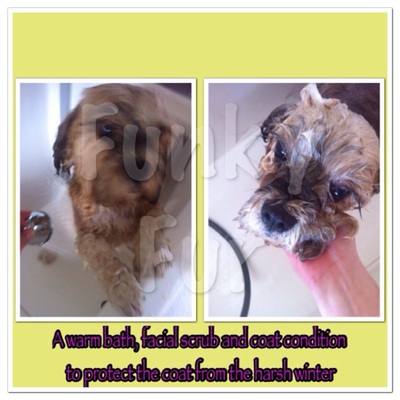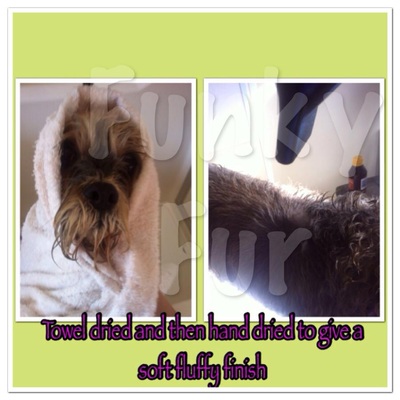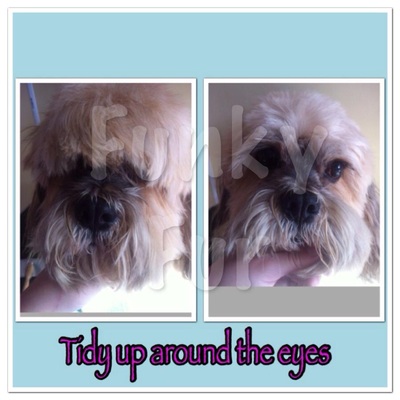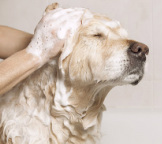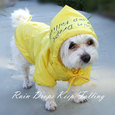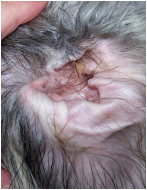 I often get asked by new clients do I pluck the dogs ear hairs; a short answer would be not unless requested. Ear plucking was once a normal part of the grooming process, but in recent years new knowledge has changed whether it is a help or a hindrance to ear health. So, what is Ear Plucking? Ear plucking is the practice of using fingers, haemostats or other tools to remove excessive amounts of hair from a dog’s ear canal. Floppy-eared dogs or very hairy breeds such as Poodle, Schnauzer, Maltese and Bichon Frise can be in need of plucking. It was originally performed because it was believed that this would help increase air flow to the ear canal and prevent all too common ear infections. It is now thought that ear plucking can have the opposite effect to what we are actually trying to prevent. When we pluck the hair from the ear canal pores are opened up from where the hairs are removed and can now become exposed to bacteria and debris. “Healthy ears are self-cleaning” The number one rule I like to follow while grooming is ‘if it’s not broken, why fix it’. Human and canine bodies do a great job of maintaining themselves. So if I come across an ear that is healthy, I usually leave it as is. However not every dog is the same and like in humans some dogs are prone to health problems. When I do come across an ear that is not too healthy my first suggestion is a vet visit. There could be a number of reasons for a problem; some examples are if the ear canals are too small, problems related to allergies, bugs or other foreign object inside the ear or a yeast infection. Once a vet has figured out the base-cause a groomer can then assist in keeping the ear clean. Shaving around the ear canal can prevent leaving pores open but still assist in air flow and help make it easier to apply any treatment necessary.
2 Comments
Going on holidays with your pet can be a lot of fun. Here are some tips to keeping your pet safe and happy while away. 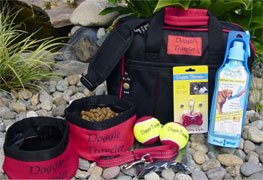 · Make sure your dog’s microchip details and I.D tags are up to date. Being in an unfamiliar environment can heighten their desire to escape and increase the risk of becoming lost. Staying on top of your pet’s identification will enable a quick and safe reunion if needed. ·Packing essentials. A list of things needed to make the experience less stressful: Ø Ample food and water (for the car ride and your stay) Ø Prescribed medication Ø Insect repellent and sunscreen (yes, dogs require this too) Ø Carrier /crate Ø First aid kit Ø Treats and toys Ø Lead and collar Ø Bedding and familiar items from home. Your dog may feel out of place in a new environment so having familiar items will help them feel more settled and at home. Ø Doggy towels if you’re heading to the beach Ø Travel food and water bowls Ø Poop bags The Journey 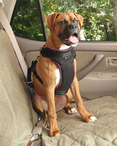 · Pet safety in the car is a must, not just for your pet but also for you and other family members in the car. Dogs should never be seated on the driver’s lap or the front passenger seat. A crate or harness is a good way to keep your dog secure and safe. · If it’s a long drive, regular breaks are essential to keeping your pet comfortable and allowing them to have a stretch, play, have a toilet break and hydrate. When You Arrive · Spend time introducing your dog to the new environment. Having a play or throw of the ball will even give the new area a positive feel.
· Check that all fences and gates are secure and if needed find a safe place that your dog can be tethered out from all the elements. · A thunder shirt is a great tool for those dogs that tend to get a bit of anxiety in new places, helps them feel safe and secure. Lastly, have fun and enjoy!! Ever seen your dog swallow a piece of food whole, or eat something that would make you sick? Here’s a break-down on how they digest their food. Human jaw- can move up and down side to side and in a rounded motion. Teeth are designed for grinding having a flatter surface. Dog jaw- can only move up and down. The teeth are designed to crush dense objects, having a three root system and are solid and sharp. Saliva Human- used for breaking down food and lubricating digestion. Dog- also used for lubricating food but they lack the enzymes to break down food. Instead their saliva contains enzymes that kill off bacteria. If you've ever seen your dog eat something old and gross and not get sick? Now you know why. Oesophagus Humans- helps keep food from entering the wind pipe and designed for food to stay in our stomachs Dogs- Good gag reflex. Even though dogs cannot chew up their food before it goes down the throat, it must still be the right size and amount to fit. If not, the dog simply throws up! Your dog is not sick. It's just his body telling him to try again. I know it's gross but completely natural. Humans- food takes about one hour to move through our stomach, but depending on the amount and complexity sometimes longer. Dogs- this is where most of their ability to break down foods take place. Their stomach is more acidic so it can break down large pieces of meat and bone. Food is kept in the stomach for a longer period of time, allowing the acid to break down animal proteins, bones, and fats. This explains why dogs can live with being fed only once or twice a day. They feel full longer because the food remains in their stomach longer. Intestines Humans- where absorption of food takes place, the human intestinal tract is a lot longer than a dogs and therefore the body has more time to absorb nutrients from more complex foods such as plant and grain based foods. Dogs-Digestive tract is a lot smaller. This means the dogs have less time to absorb nutrients from their food. This is why dogs do better on foods that are easily broken down such as meats bones and organs. But can struggle on complex foods such as plants and grains. This also means that bacteria have less time to multiply and cause problems. Ever seen your dog eat poop? Yes very gross, but plant based nutrients found in poo have been pre-digested making it a very convenient meal for our canine friend. Yes some of our doggy friend’s habits may not be socially accepted by human standards but as you can see there may be reasoning behind their behaviour. Just maybe hold back from those doggy kisses!
We hear about a lot of foods that we should not feed our dogs but sometimes it’s hard to get an understanding of why? Here is a list of foods that can be dangerous to your dogs and why:  Macadamia Nuts Macadamia nuts are unlikely to be fatal in dogs, it can cause very uncomfortable symptoms that may persist for up to 48 hours. Affected dogs develop weakness in their rear legs, appear to be in pain, may have tremors and may develop a low grade fever. Fortunately, these signs will gradually subside over 48 hours, but dogs experiencing more than mild symptoms can benefit from veterinary care. The mechanism of toxicity is not known. Dogs need to ingest more than 2g of nuts per kilogram of their body weight before signs are shown. 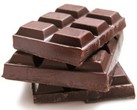 Chocolate Many of us have heard not to let dogs eat chocolate, but why? Chocolate contains a caffeine-like substance called theobromine. Dogs metabolize theobromine more slowly and can get sick and die from eating too much chocolate. How much is too much? It depends on the type of chocolate, so if your dog has ingested chocolate it is best to contact your vet immediately so they can advise you on the next step to take. This affects a dog's nervous system and can result in vomiting, diarrhoea, irregular heartbeat, tremors, seizures, and even death.  Fruit Seeds and Stones The pits in stone fruits can obstruct your dog's bowels. They also contain small amounts of cyanide, which is poisonous to dogs (and humans). Apple Seeds - The casing of apple seeds are toxic to a dog as they contain a natural chemical (amygdalin) that releases cyanide when digested. If a large amount was eaten and the seeds are chewed up by the dog, this can cause the chemical to enter its blood stream. To play it safe, be sure to core and de-seed apples before you feed them to your dog. 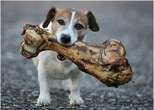 Cooked Bones When it comes to bones, the danger is that cooked bones can easily splinter when chewed by your dog. Raw (uncooked) bones, however, are appropriate and good for both your dog’s nutrition and teeth. 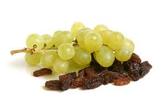 Corn on the Cob This is a sure way to get your dog’s intestine blocked. The corn is digested, but the cob gets lodged in the small intestine, and if it’s not removed surgically, can prove fatal to your dog. Additionally, too much corn kernels can upset the digestive tract as well so be cautious to not feed too much. Mushrooms Just as the wrong mushroom can be fatal to humans, the same applies to dogs. Grapes and Raisins Grapes and raisins have been found recently to induce kidney failure in some animals. This failure can be permanent and life threatening. It does not seem to relate to the volume ingested, and not all animals seem to be equally susceptible. Although some dogs have been eating grapes for years, the safe course is to avoid grapes and raisins completely. 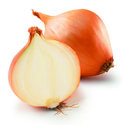 Onions Onions are tasty for our pets as well as us, but too many onions can be dangerous. High levels of onion ingestion in dogs and cats can cause life-threatening anaemia. The levels of thiosulfate found in onions means that even small amounts can hurt and quickly kill your dog, cat and other pets. Onions also contain allyl propyl disulphide, which causes permanent damage to red blood cells, causing anaemia and oxygen deprivation. Animals that eat onions can suffer from liver damage, discoloured urine, difficulty breathing, dermatitis and anaemia. 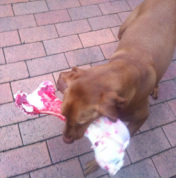 I love to spoil Chase! He just needs to give me that look over his shoulder and I want to drown him in food and love, but it’s the food part that can sometimes be dangerous for our dogs. Not only can it add kilos to their waist line, some products contain ingredients that may not be good for our pets. So here are some healthy snacks that can keep your pets happy and their waist line trim. 1. Raw Meaty Bones This is one of my favourite snacks/meals for Chase. Not only are they a great boredom buster, they can also give your pet a good workout (watch how your dog uses the muscles in their legs upper body and jaw to eat) and can offer your pets a lot of good nutrients. What are some bone no no-s? · Never feed your pet cooked bones. This can splinter into shards and cause health issues for your pet. · Be careful when giving bones around young children. Dogs may become aggressive or guard bones if they have not been taught to relax around people and their bones. If you have children or even strangers at your house make sure the dog has its own private space to eat that bone and people are aware that your dog has a bone in its possession. · Appropriate bones for your dog’s size and eating habits - If your dog tends to swallow their food whole or eat fast, larger bones are best that you know they cannot swallow whole. Same goes for smaller dogs to get the best nutrients from a bone you want to give them ones they can chew and eat all of. What are my favourite types of bones for Chase? The No. 1 bone I love to give him is lambs necks. For smaller dogs chicken necks are great as well as chicken wings and legs. You can also give lamb shanks, whole chicken carcases, and large beef bones for those scoffers.  2. Vegetables and Fruits. Chase’s favourites are raw carrots, raw broccoli, cooked pumpkin, apples (make sure seeds are removed) pears (also seeds removed) capsicum and zucchini. Other vegetable and fruit suggestions for your dogs can be: spinach, oranges, asparagus, blueberries, strawberries, peaches 3. Dried Treats
While these should be very occasional foods, they can also be great treats. This includes dried liver, pigs’ trotters, roo meat as well as dried sweet potato, pumpkin and carrots. If you own a food dehydrator, why not make your own!  Got a pooch that eats like you are throwing a raw chicken to a starving crocodile? This behaviour can cause problems such as vomiting, food aggression and bloating. So here are some inexpensive tips to slow down their eating habits:  1. Changing their bowl - Making food harder to access from the bowl is one way to slow down your dog. One easy way to do this is to flip their stainless still bowl upside down. The crevice makes it harder to get to the food. Muffin trays are also a great idea; it divides the food into smaller portions and allows the dog to pause between mouthfuls. You can also place a tennis ball on top of each muffin cup and turn it into a fun game! 2. Nothing in life is free - This is the number one rule for dogs that I find helps with many behavioural problems. Not only does it create good manners it also changes the dogs thinking process from scoffing food as fast as possible, to slowing down and thinking about what they have to do next to receive that food. It is also a great bonding experience. How it works: Start out simple, asking your dog to sit and hold that sit until you give a release command. Asking your dog to preform a task before giving each portion of food. 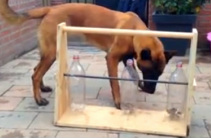 3. Feeding toys and games - Another great way is toys and games. However while they do work well there is no need to buy expensive food balls. Filling containers such as water or coke bottles with food works cheaply and effectively. You can also use PVC pipes with the ends sealed and holes drilled for the food to drop through. Placing food in an old cereal box and sealing the ends is another great idea. 4. Food mats and slow feeders - Their are many on the market. adding stickier foods can increase the complexity of removing food. 5. Splitting up family members - Sometimes fast eating can be caused by fear that food is going to be taken by other family members. Giving them their own space when eating takes out that fear and allows the dog to eat in a calm manner. 6. Scatter food- Skip the bowl completely and throw the food on the ground for your dog to search. or hide in different locations around the yard A bath and Tidy is great for inbetween grooms, specially during those cold winter months when a full groom maybe to much. This service can help keep your pet matt free, allow the coat to gain length, give a healthy coat all year round and keep them hygienic and smelling fresh.
So what happens after you drop your puppy off for a Bath and Tidy at Funky Fur? Check out the process below. The right shampoo is a big part in keeping your pets coat healthy. There are many factors that determine the health of a dogs coat, and while I cannot always control internal factors, I can assist in helping externally.
So how do I pick the right shampoo for your dog ? The first step I take is research. I make sure I have an understanding on what goes into the shampoo and how it works. Here are lists of ingredients I avoid when picking and why. SLS (sodium lauryl sulphate) and SLES (sodium laureth sulphate) are types of detergents or surfactants. Detergents are the most abundant ingredient in a shampoo and makes up about 10-15% of a formula. It lifts oils and dirt and carries it away from the coat. So why do I avoid SLS and SLES? There is a lot of mixed research on how these surfactants affect the skin. What we do know is it can be very drying and cause skin and eye irritations. As there are many other alternatives to these detergents I feel it’s better to be safe and avoid. Parabens are a preservative added to products to give them a longer shelf life and to inhibit the growth of bacteria. Parabens are known to cause skin, eyes and respiratory irritations and allergic reactions. They also can be absorbed by the skin, blood and digestive system. Endocrine disruption: Of greatest concern is that parabens are known to disrupt hormone function, an effect that is linked to increased risk of breast cancer and reproductive toxicity. Formaldehyde also used as a preservative. Formaldehyde is considered a known human carcinogen by many expert and government bodies, and has been linked to leukaemia. Widely understood to cause allergic skin reactions and rashes in some people Testing a chosen shampoo This product has been tested on humans Yes I admit I test all shampoos on myself before using it on any pets. While our ph. levels maybe a little different, I can get a better understanding on how the product feels during and after the process and if any irritations occur. I also see how the product affects my hands, using shampoo all day every day I know if a product is going dry out my hand it will do the same for the dogs skin. There are some cons to being a groomers dog Yes poor Chase sometimes is my next guinea pig. Chase suffers from external allergies so if a product is ok with him it will be for most other dogs. I also can keep watch over him for 24hrs and close to bathing facilities if a reaction occurs. Test patches and observation. Lastly is your pet. I carry a wide range of shampoos; everyday, medicated, clarifying, whitening, soothing, deep clean. So how do I know which one to use? At the beginning of every visit I assess your dogs coat to see if its oily, dry or brittle or flaky and from their decide which will best help correct the skin to a normal ph balance . Once the skin starts to normalise itself i will change back to a gentle everyday shampoo. Many factors can change your pets coat from one visit to the next so my shampoo choice on your pet will also change making sure what leaves my salon is a healthy coat and happy pet. 1. HIDE AND SEEK
This can keep your pet entertained for hours with enough variety to prevent it becoming repetitive. Start by getting your dog to stay while you go and hide somewhere in the house. At first hide somewhere they can still see you and offer treats as a reward when they find you. Then you can gradually make things more difficult hiding well out of sight. The game can be transferred to your dog’s favourite toy or treats. 2. TUG OF WAR This is another great energy release game for both you and your pets. It’s important that your dog knows a ‘release’ command to let go of the tug toy when needed. 3. INTERACTIVE TOYS You can find many interactive toys at your local pet shop but are also easy to make your self at home. A drink bottle with a small neck filled with dog or cat food. Or you can fill one with raw rice and close the lid tightly the noise will entertain your dog for hours. 4. GROOMING All dogs need grooming and love the extra attention. Not only will this help you bond with your pet it will also keep the coat healthy and matt free. 5. PASS THE PARCEL Nothing more fun than unwrapping a present and your dog loves it too. Wrapping their toys and treats in different layers of newspaper and watch him have fun finding what’s inside. |
AuthorBianca is the owner and groomer at Funky Fur dog grooming and always looking for ways to help you care for your pet. Archives
September 2022
Categories
All
|
